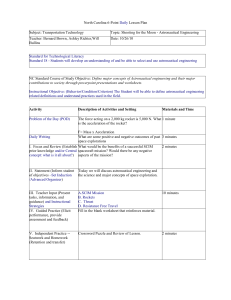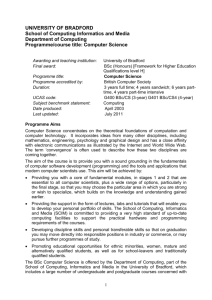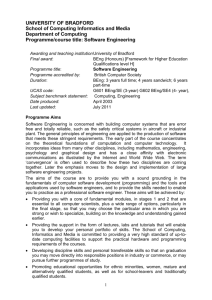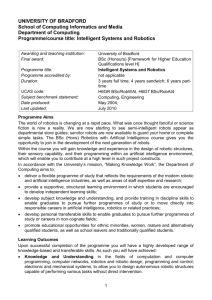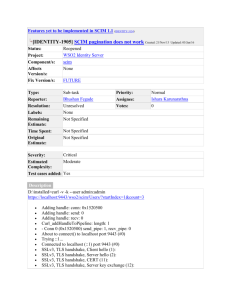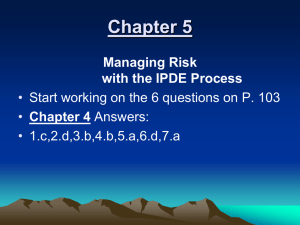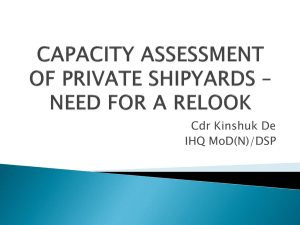20101207_Joint_Panel_Meeting_-_ILE_Project_Status_
advertisement
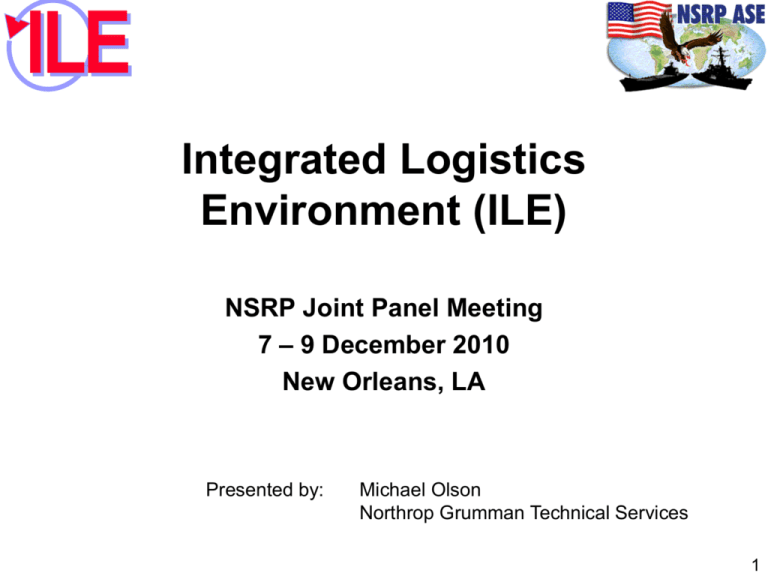
Integrated Logistics Environment (ILE) NSRP Joint Panel Meeting 7 – 9 December 2010 New Orleans, LA Presented by: Michael Olson Northrop Grumman Technical Services 1 Agenda Ship Common Information Model (SCIM) Overview Integrated Logistics Environment (ILE) Overview SCIM Validation Process Adopting the SCIM for Production Use 2 Overview NSRP has led the way in developing standards and prototyping tools to facilitate product model exchange between shipyards and the Navy throughout the life cycle of the ship In conjunction with the Navy Product Data Initiative (NPDI) effort, a Ship Common Information Model (SCIM) was defined to specify information exchange requirements within and among IPDE environments throughout the life cycle of the ship The current project for an Integrated Logistics Environment (ILE) is evaluating and validating the SCIM models that have been developed, as well as completing the SCIM document for several additional disciplines 3 Product Model Data Needs to Transition Throughout the Life Cycle Preliminary Concept Detail In Service Support Construction/Test Decomm. Milestone Reviews/ Decision Points IPDE/PDMs maintained by Maintenance Contractor SCIM IPDE/PDM maintained by Design Agent/Builder To External Systems/ IPDEs Archive • During design and construction phases a set of PDM and application tools capture and maintain product model data in native format • At any time during those phases, product model data may need to be transferred to external systems or archived • These transfers should comply with the Ship Common Information Model (SCIM) 4 Ship Common Information Model (SCIM) Overview 5 SCIM Background The SCIM provides an information model that defines the data exchange requirements to enable interoperability among Shipyard and Navy systems Background – Information models developed, prototyped, and tested under the NSRP Integrated Shipbuilding Environment (ISE) Project – SCIM is codifying the information models developed under ISE Association with NPDI IPDE Specification – Separate document referenced by IPDE Specification – SCIM will be placed on Web and made available to the Shipbuilding community 6 SCIM Relationship to other Ship Product Model Data Exchange Standards The ISO STEP Ship Application Protocols define the requirements for sharing data between and among Shipyards, the Navy, Commercial ship owners, and Classification Societies CAD Vendors have not implemented the ISO Ship APs as Shipbuilding is a small part of their customer base The U.S. Yards and Navy need a version of the ISO Ship APs that are implementable in-house and fulfill just the requirements for Navy shipbuilding The SCIM subsets the ISO STEP Ship AP Object definitions to what is needed just for Navy ships, in a data format (XML) that can be extracted from commercial CAD/PDM systems, and that can be cost-effectively supported by Shipyard IT developers 7 SCIM Application Areas SCIM Chapters Completed PDM and Change Management Fundamentals Structural Moulded Forms Ship Arrangements Structural Detailed Design Piping Functional Design Piping Physical Design Common Parts: Procurement Product Life Cycle Support To be Validated under Task 1 SCIM Chapters Required HVAC Functional Design HVAC Physical Design Electrotechnical Functional Design Electrotechnical Physical Design Engineering Analysis Pipe Stress Analysis Structural CAM To be Developed under Task 2 8 Completed Sections of the SCIM PDM and Change Management Fundamentals Structural Moulded Forms Piping Ship Arrangements Functional Design Structural Detailed Design Piping Physical Design Common Parts: Procurement Product Life Cycle Support •SCLSIS/CDMD-OA for Navy Logistics •S1000D Electronic Document Authoring 9 Sections of SCIM to be Completed in ILE Phase 2 (2011/12) HVAC Functional & Physical Design Structural CAM Electrotechnical Functional & Physical Design Pipe Stress Analysis Engineering Analysis 10 Integrated Logistics Environment (ILE) Overview 11 Integrated Logistics Environment (ILE) • Task 1 – Tools and Methods for Supporting the Next Generation Shipbuilding IPDE (SCIM Evaluation) • Subtask 1.1 – Migrating VIRGINIA Class IPDE Data • Subtask 1.2 - Exchanging Structural Design Data with Manufacturing Systems • Task 2 – Completion of the Ship Common Information Model (SCIM Development) 12 Objectives Apply the tools and methods developed by the ISE team to two current shipbuilding requirements – VIRGINIA Class IPDE data migration – Sharing of structural design data with manufacturing systems across shipyards Demonstrate the use of the NPDI SCIM as a means for supporting Shipyard and Navy interoperability Complete the development of the SCIM 13 Deliverables Each task has a set of Deliverable reports There will be a Wrap-up Meeting and Final Report in Washington, DC at the conclusion of Month 12 for the SCIM Evaluation Task (Task 1) and at the conclusion of Month 24 for the SCIM Development Task (Task 2) There will also be a Business Status Report and a Technical Status Report issued as a Deliverable at the end of each Quarter 14 ILE Phase 1 Subtask 1.1 VIRGINIA Class IPDE Data Migration 15 VIRGINIA Class IPDE Data Migration Migrating VIRGINIA Class IPDE Data VIRGINIA has been designed in an IPDE environment featuring CATIA and CDM Migration is currently underway to a new IPDE featuring NX and TeamCenter VIRGINIA design and construction efforts will continue for several more years, so the VIRGINIA product models must be successfully moved to the new IPDE Task is led by Electric Boat Corporation 16 VIRGINIA Class IPDE Data Migration VIRGINIA Class submarine is in the midst of its production cycle with several more hulls pending VIRGINIA Class IPDE – Platform is approaching its end of life and EB is in the process of implementing a new next generation IPDE – Highly customized solution that evolved and grew as the VIRGINIA Class design progressed and as new requirements and issues revealed themselves Exact entities, attributes, properties, and relationships that must be migrated to the new IPDE are not obvious Several difficult technical questions must be resolved before a successful data migration can be completed 17 Extraction of Piping & Structural Models SCIM is intended to provide the information requirements to guide the extraction of product data and specifies the entities, attributes, and properties required SCIM was not available in time to support early efforts of VIRGINIA data migration This task will be primarily focused on validating the SCIM, rather than on assisting VIRGINIA Class data migration Focus will be on Piping & Structural Models – These represent a major portion of the VIRGINIA product model – SCIM chapters relating to these disciplines have already been completed – Piping & Structural Models will be extracted from the current CATIA / CDM IPDE and transformed to SCIM representation – SCIM models will be analyzed manually to identify errors or discrepancies 18 Load SCIM Models into NX / TeamCenter Environment Translators and/or mediators will be developed as required to load the SCIM models into the new IPDE environment using NX and TeamCenter These models can be evaluated in the new IPDE as far as completeness and accuracy Models will be processed on the new system to verify their validity and completeness 19 Validate SCIM Models Note Any Deficiencies Any deficiencies revealed in the SCIM chapters relating to Piping or Structures will be noted and corrected as part of Task 2 under the ILE Project Also, if difficulties are encountered in using the SCIM because of incompleteness or lack of clarity in the SCIM descriptions, an attempt will be made during Task 2 to improve the format of all the SCIM chapters to resolve these problems 20 SCIM Chapters Needed for VIRGINIA Migration This task will be attempting to validate the SCIM approach and will be looking in detail at the information models in four different SCIM Chapters – Product Data Management (PDM) – Piping Physical – Piping Functional – Structural Detailed Design 21 Current Status Information model for piping migration developed by Electric Boat and comparison with SCIM Piping Models documented Development of information model for structures migration is underway Analysis is leading to improvements in the data migration models, as well as recommended enhancements to the SCIM 22 ILE Phase 1 Subtask 1.2 Exchanging Structural Design Data with Manufacturing Systems 23 Objectives Demonstrate use of NPDI SCIM as means for supporting next generation IPDE Address data sharing challenge in multiple shipyard development environments – Exchange of structural design between prime designer and manufacturing, either in same shipyard or second shipyard Validate and demonstrate capabilities of the SCIM on current programs Recommend improvements to SCIM 24 Participants Northrop Grumman Shipbuilding – Gulf Coast Northrop Grumman Shipbuilding – Newport News Northrop Grumman Technical Services Product Data Services Corporation 25 Approach Define the data model for the exchange of structural design data with manufacturing using existing programs as examples Compare the data model to the SCIM data model Identify gaps in the SCIM data model Make recommendations for improving the SCIM 26 Business Context Used ISPE Common Process Model to define the Business Context for the task – Reviewed by NGSB-GC and NGSB-NN to confirm applicability Focus on exchange of Design Product Model with manufacturing in order to perform production planning function and develop Manufacturing Product Model 27 Business Context 28 Business Context Product Models • Moulded Forms & Lines • Preliminary scantlings • Structural systems • Unit Breakdown Scantling Design • Structural Part Definition • Structural Part Relationships • Seams • Features 3D Detailed Design • Assembly breakdown • Assembly order • Welds • Bevels • Bending lines • Flat pattern parts • Marking Lines • Shipyard specific parts • Added material • Marking lines, Labeling • Tabs • Manufacturing Aids Functions Detailed Design Production Planning 3D Manufacturing Piece Part Development 2D Neutral Piece Parts Manufacturing Definition 2D Shipyard Piece Parts Nesting Drawings & Reports NC 29 Business Functional Requirements Describes high level business functional requirements for the shipyard common process Functional requirements described as a set of use cases and provide the basis for deriving the data requirements ISPE common process areas serve as three high level use cases within the shipyard environment: – Create Detailed Design Product Model – Create Manufacturing Product Model and Parts – Manufacture Ship 30 Business Functional Requirements Planning •Scheduling •BOM maintenance •Unit arrangements •Assembly sequences Material Mgmt •Material Requirements •Procurement •Material tracking Preliminary Design •Hull Form Development •Fairing •Naval Architecture •Scantlings Mfg Product Model •Bevels, Welds, End cuts •Construction Drawings •Mfg Product Model Production Control •Work Orders •Production oversight Detailed Design •Interference Checking •Penetrations •Detailed Design Product Model Lofting •Shell Plate Development •Nesting •Part Generation •Work Packages •Mfg Aids Create Detailed Design Product Model Create Manufacturing Product Model and Parts Production •Plate/Profile cutting •Fabrication •Assembly Manufacture Ship 31 Structural Model Requirements Analyze data exchange between design and manufacturing for current programs – DDG 1000 – CVN21 Focus on structural design data required for manufacturing – Detailed Design Product Model used to perform production planning activities 32 Use of SCIM Use SCIM chapter based on STEP AP 218 (Ship Structures) as starting point Include additional SCIM chapters as necessary, such as Product Data Management (PDM) Augment SCIM chapters as necessary to include required manufacturing data 33 Export from Design Environment Develop translator to map structural design data to SCIM XML file – Map data to appropriate SCIM entities and attributes – Add entities and attributes to SCIM as needed to meet manufacturing data requirements – Evaluate data for completeness and accuracy 34 Validate SCIM Validate that the SCIM chapters meet Navy and Shipyard requirements for specified data exchange scenarios Correct SCIM Structural Design Data deficiencies in future releases of SCIM Make recommendations for improving SCIM usability, including completeness and clarity of SCIM descriptions, format and content 35 Current Status Analyzed current SCIM AP 218 Chapter against STEP AP 218 to understand data and scope of SCIM – Noted potential issues that need to be addressed Coordinated with NGSB-GC DDG 1000 IDE team – Analyzed CATIA to Teamcenter Enterprise (TcE) interface – Analyzed TcE to Teamcenter Manufacturing (TcM) interface – Documented Design to Manufacturing data exchange requirements Coordinated with NGSB-NN CVN21 – Analyzed CVN21 design to manufacturing data exchange – Documented Design to Manufacturing data exchange requirements 36 Current Status (cont’d) Developed Structural Model Import Requirements Report – Leveraged analysis and data produced for NSRP Integrated Steel Processing Environment (ISPE) project as a framework for organizing and analyzing data Currently analyzing gaps between Shipyard data and SCIM Structural Design chapter 37 Integrated Logistics Environment SCIM Validation Process 38 Objectives Validate that the SCIM chapters meet Navy and Shipyard requirements for specific data exchange scenarios 39 Approach Define a repeatable process for validating the Ship Common Information Model (SCIM) – Focus on content (not format or systems used) – Use existing program data and requirements when possible 40 SCIM Validation Process 1 Define a Data Exchange Scenario (Use Case) 4 2 Define Data Exchange Requirements 5 Compare SCIM to Data Exchange Requirements 7 Augment SCIM Context Schema to Satisfy Data Exchange Requirements 6 Import SCIM Data Exchange File into Target System(s) 9 8 Develop SCIM Exchange File 3 Identify Applicable SCIM Chapters Develop SCIM Test Case Data Evaluate Imported Data in Target System(s) Verify SCIM Exchange File Meets Requirements 10 41 Integrated Logistics Environment Adopting SCIM for Production Use 42 Adopting SCIM for Production Use The Shipyards need to share data among Design, Manufacturing, and Logistics applications The Shipyards need to share data with their co-design and manufacturing partners The Shipyards need to deliver data to the Navy, and the Navy to the Shipyards Data in SCIM format can feed later lifecycle uses such as AP239 Ship Logistics support, simplified product model visualization, and part information within the Navy’s systems 43 What remains to be done… The information exchange requirements assembled by ISE have been published in a formal, XML-based notation Remaining work: package the ISE work in a manner that is – – – – – Fully documented and user-friendly Usable by shipyard personnel, including non-IT specialists Capable of validation Suitable for contractual specification Of practical use for agreements between shipbuilder and CAD/system vendors ILE Project is completing this remaining work – SCIM will be available for production use by 2012 44 What remains to be done… “ISE Information Model Methodology” was developed years ago to show plan for adoption of ISE Information Models ISE has achieved the top two lines for the major product disciplines ISE Information Model SCIM is publishing Methodology and managing models Standard ISO STEP Standard In Work Approved We are here ! Information Reqmts Information Prototype Testing must now be: NSRP ISE Model Translators Framework – Invoked on Navy Contracts – Implemented by Shipyards and Vendors Registry NAVSEA Contractual Specification Deployment Integration, Testing Ship Program Phases: Requirements Definition Information Interoperability Specification Production Deployment 45 Conclusion Significant investment in interoperability and data exchange standards by the Shipyards and Navy through NSRP SCIM is validating and publishing the results of this investment Next step is to implement the SCIM for specific high priority data exchange scenarios within the Shipyards and Navy Need feedback from Shipyards, Navy, and NSRP on candidate scenarios for implementation 46
